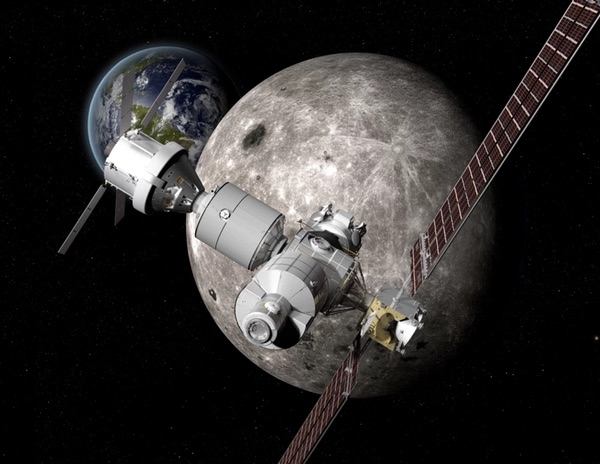The Lunar Orbital Platform-Gateway: an unneeded and costly diversionby Gerald Black
|
| LOP-G is an unneeded and costly diversion that should be promptly relegated to the dustbin of history. |
Two components have emerged in NASA’s plans to return to the Moon. The first is to establish a human tended space station in lunar orbit. Originally called the Deep Space Gateway, this program was renamed the Lunar Orbital Platform-Gateway (LOP-G) by the Trump Administration. The second component is to return humans to the surface of the Moon and establish a lunar base. Thus far NASA has been short on details regarding the latter.
But can we afford to do both components? The answer is a resounding no! Returning humans to the lunar surface is the primary goal of the Trump Administration and is the consensus goal. It is a goal that will inspire the public and the next generation of scientists and engineers. LOP-G is an unneeded and costly diversion that should be promptly relegated to the dustbin of history.
LOP-G is a left-over concept from the Obama Administration, which wanted to do something near the Moon as a bridge to human missions to Mars. It also meshed well with the Obama Administration’s Asteroid Redirect Mission (ARM), a plan to transport a boulder from a near Earth asteroid to lunar orbit. But the ARM project has been cancelled and human missions to Mars are on indefinite hold. And most of the architectures for human Mars missions (including Robert Zubrin’s Mars Direct plan and Elon Musk’s Big Falcon Rocket plan) envision departing from Earth orbit, not lunar orbit.
The LOP-G crew would spend their time in lunar orbit, but for what purpose? Microgravity experiments can be more easily accomplished in low Earth orbit (LEO), and lunar science can be accomplished much less expensively by robotic lunar orbiters.
In lunar orbit, the crew would be subjected to the deleterious effects of radiation (double that of LEO) and microgravity. These conditions would require frequent crew rotation. But if crews went directly to the lunar surface, they could stay for lengthy periods of time. They would be protected from radiation by a habitat covered by lunar dirt, and lunar gravity (16 percent of Earth’s gravity) is bound to be less harmful on the bones and muscles than micro-gravity.
Arguments for LOP-G include using it to continue our ISS international collaborations. But other countries want to have their astronauts walking on the Moon, not just hanging out in orbit above it. NASA would do better having our international partners develop lunar habitats, surface power systems, pressurized rovers, and other needed lunar infrastructure.
| We don’t need a new program that would likely drain $3 billion per year from the NASA budget. The money would be much better spent on the consensus goal of returning humans to the lunar surface and establishing a lunar base. |
In the future, it may well make sense to have a propellant depot in lunar orbit or at the Earth-Moon L1 Lagrange point. The propellant depot would be used to store liquid oxygen and liquid hydrogen propellants produced from lunar water. But that is not part of the LOP-G plan. A propellant depot in lunar orbit or at L1 should be deferred until it has been demonstrated that propellants can be extracted economically from lunar water.
LOP-G is useless for supporting human return to the lunar surface and a lunar base. Since a propellant depot is not part of the LOP-G plan, stopping at LOP-G on the way to or from the Moon would serve no useful purpose. Instead it would be detrimental, since rendezvousing with LOP-G would needlessly waste rocket fuel. NASA would do better transporting astronauts directly to the Moon, rather than detouring to a government station for no discernable reason. LOP-G is like a gateway without a gate: useless as a gateway to anywhere.
The first module of LOP-G (the Power and Propulsion Element) would be launched aboard a commercial launch vehicle. However, the other modules (a habitat module, a logistics module, an airlock, and possibly others) would be launched aboard NASA’s Space Launch System (SLS). Since it is totally expendable, uses outmoded technology, will have an infrequent launch rate, and is a cost-plus contract, the SLS is hugely expensive: probably about $2 billion per launch. LOP-G would also utilize the Orion spacecraft, another hugely expensive project that utilizes a cost-plus contract.
LOP-G is in its infancy, with only several study contracts issued to companies thus far, and no prime contractors chosen. The time to kill this project is now, before it becomes an entrenched project with strong industry backing. We don’t need a new program that would likely drain $3 billion per year from the NASA budget. The money would be much better spent on the consensus goal of returning humans to the lunar surface and establishing a lunar base. The latter is a program that desperately needs the money if it is to be successful.
Note: we are temporarily moderating all comments subcommitted to deal with a surge in spam.
